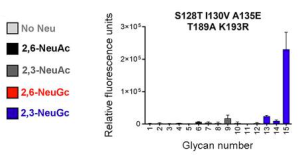A group from Department of Chemical Biology & Drug Discovery, Utrecht Institute for Pharmaceutical Sciences, Utrecht University, Utrecht, the Netherlands, etc. has reported that the binding specificity of hemagglutinin on influenza A virus can be switched from NeuAc to NeuGc by introducing several mutations.
https://pubmed.ncbi.nlm.nih.gov/35044215/
Influenza A viruses (IAV) initiate infection by binding to glycans with terminal sialic acids on the cell surface. Hosts of IAV variably express two major forms of sialic acid, N-acetylneuraminic acid (NeuAc) and N-glycolylneuraminic acid (NeuGc). NeuGc is present only in species that express an active form of the enzyme CMP-N-acetyl neuraminic acid hydroxylase (CMAH), which facilitates the hydroxylation of NeuAc to convert it to NeuGc. The gene encoding CMAH, mainly expressed in mammalian species, has been partially or completely lost at several distinct events during evolution, causing NeuGc to be absent in, among others, humans, ferrets, European dogs, and avian species.
NeuGc binding specificity on hemagglutinin was achevied by the following methods,
(1) combining mutation A135E with mutations I130V or T189A+K193R in A/Chicken/Jalisco/12283/2012 H7N3 HA,

(2) combining five mutations S128T, I130V, A135E, T189A, and K193R in A/Turkey/Italy/214845/02 H7N3 HA, and

(3) combining three mutations A135E, D189A, and K193R or five mutations S128T, I130V, A135E, D189A, and K193R in A/Duck/Australia/341/1983 H15N8 HA.

